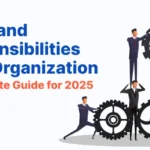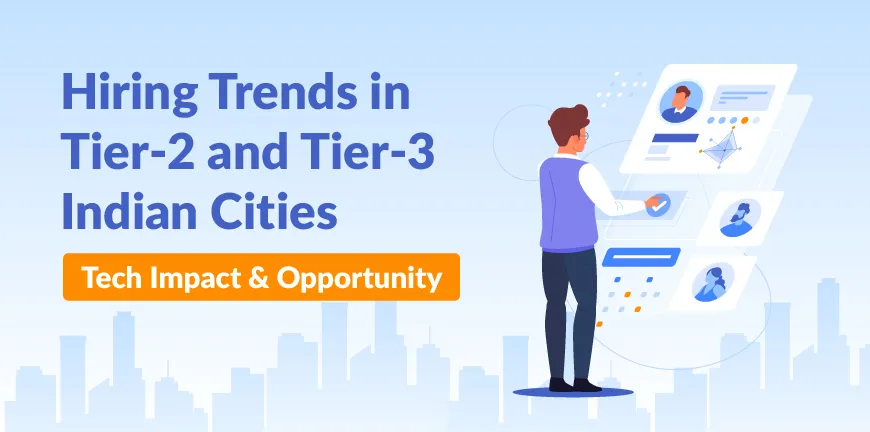
Roles and Responsibilities in an Orgazisation: A Complete Guide for 2025
27/10/2025
Remote Hiring by Japanese Firms: How Indian Workers Can Benefit
27/10/2025Non-metro cities today are no longer playing roles on the sidelines in the tech recruitment saga. India’s Tier‑2 and Tier‑3 cities are eventually surfacing as new growth and talent centres, especially for tech and associated roles. To boost the Digital India revolution, in the tier 2 and tier 3 cities, the government has taken a slew of initiatives to enhance digital infrastructure, digital literacy, and assistance to local entrepreneurship.
According to reports, in the first half of 2025, IT hiring in smaller cities spiked by over 50% year‑on‑year, while Tier‑1 cities showed growth of about 12‑to 15%.
Here is a look at what is changing, what that means for employers, candidates, and the work landscape overall:
Trend Drivers
There is an array of powerful forces propelling recruitment to smaller cities. They join hands to make Tier‑2/3 cities appealing to organizations and job seekers. Let’s have a look at some of them:
1. Flexible Work Modes: The New Norm
The pandemic era established that it doesn’t require tech and support roles to be executed physically from metro centres. This makes way for the operation in remote or hybrid settings, even from smaller cities. Professionals from these cities can efficiently contribute without shifting cities. Employers are also looking at hiring diverse individuals based on their skills and not their location.
2. Enhanced Digital Framework
Tier 2 and 4 cities today have rich resources like improved internet connectivity, affordable data packs, better workspaces, improved training processes, etc. This enables professionals living in the cities to upgrade themselves and be prepared for job roles.
3. Employer Cost Efficiency
According to surveys and reports, businesses save on additional expenses and operational costs as the real estate prices, operational costs, and utilities costs etc, are low. The salaries are also much lower than in metro cities, and people are unlikely to leave, making operating and scaling from these cities smooth.
4. Government Policies and Incentives
Some state governments are focusing on offering incentives to IT and ITES organizations to attract them to small cities. This is driving the Centre’s Digital India initiative in Tier 2 and 3 cities.
5. High Demand Across Industries
There is a rising demand for the expansion of various sectors and not just tech. Sectors like healthcare, logistics, and e-commerce are rapidly growing in tier 2 and 3 cities, leading to a significant demand for tech, data, and analytics support in various domains.
In-Demand Roles
- Software/web development roles (both fresher and mid-level)
- Supporting functions: customer support, operations, non-voice/voice roles, BFSI back‑office roles
- Data/AI/ML/Analytics roles, cybersecurity, etc., emerging (esp. in some Tier‑2 cities) as firms raise their digital/tech maturity.
- Entry-level/early career roles dominate a large chunk of hiring. People with 0‑3 years of experience are seeing more opportunities.
Advantages and Scope
The shift to small cities creates myriad opportunities for businesses, job seekers, and regulators. Let us have a look at what they are:
For Businesses
- Companies have a chance to dive into a diverse talent pool and get connected to institutes and engineering colleges in smaller cities that present graduates who have not shifted to metros yet.
- They do not have to deal with high overheads, mainly real estate and operational costs, and can enhance margins in the process.
- Companies don’t have to aggressively compete for talent like in other metro cities, and there are fewer chances of saturation.
- There is a greater chance for high loyalty levels and individuals not quitting organizations, as people will be unwilling to leave the cities closer to home.
For Job Seekers
- Greater opportunities without the need to shift to metros
- Improved flexibility due to remote and hybrid job roles.
- Skill building to compete with ongoing training and certifications
- The new hubs might turn out to be better with a good quality of life and a cheaper cost of living.
For Government and Ecosystem
- Smaller cities developing economically diminish migration pressure on metros
- There is an enhancement in infrastructure investment and overall growth
- Scope of new ecosystem development with startups and service centres.
Challenges
The opportunity is significant, but some risks and challenges must be addressed.
| Challenge | Impact | Solution |
| Skill Gaps and Role Mismatch | Many job seekers may lack niche skills, specialization in domains, or experience required for newer positions. | Invest in upskilling, partnerships with local educational institutes, bootcamps, mentorship programs, and designing training pipelines. |
| Infrastructure and Connectivity Issues | Internet stability, power, and reliable infrastructure may still lag in many geographically remote Tier‑3 locations. | Partnerships with local/state governments; investing in backup systems; choosing hybrid work setups as a buffer. |
| Cultural and Management Differences | Remote or satellite teams need good management, culture integration, and communication. Without this, attrition or quality issues can arise. | Strong onboarding practices, local leadership/liaisons, clear communication, and remote team best practices. |
| Retention and Career Growth | Talented people may still want to shift to metros for exposure/career growth; the risk of losing them is. | Clear career pathing, remote leadership/rotation options, exposure to interesting work, and hybrid structures. |
| Identifying Talent and Hiring | Finding good candidates locally (especially for niche skills) can be harder due to fewer networks, fewer experienced people. | Extended outreach, leveraging online platforms, hackathons, local coding contests, and remote hiring strategies. |
How Employers Can Act
Employers must be smart to adopt the approach and use methods intelligently.
- Recruit Local and Remote workers: Employers must amalgamate remote and hybrid work by connecting with local centres. They must also try to establish satellite offices in Tier‑2 cities.
- Initiate Skill Development: Organizations must collaborate with colleges, universities, institutions, and online education platforms etc, to organize training or apprenticeship programs catering to Tier‑2/3 students.
- Flexible Work Modes: There must be implementation of flexible work policies where firms ensure providing adequate support and resources, ensuring that employees work comfortably in a remote work setup in smaller cities.
- Localized Employer Branding Strategies: The brand image of organizations and employers must be established in smaller cities. Employers can be a part of local communities, participate in local events, fairs, campus programs, etc.
- Upgrade Skills: Employees who work in non-metro offices must have the motivation to contribute to organizations and move up the ladder. To support them, employers must offer certification, mentorship, and training programs. Utilize Technology Tools: Employers must leverage online recruitment tools, AI-powered tools for review, virtual training sessions, etc. They must also utilize cloud-based platforms for hiring and other operations.
The Future Vision
Here are some future predictions and possibilities:
- Secondary tech hubs gaining prominence: Tier 2 cities like Indore, Jaipur, Lucknow, Coimbatore, Bhubaneswar, etc., are likely to surface as hubs for tech operations that will include domains like engineering, IT, support, etc.
- Remote-centric companies might look at setting up their central operations in small cities to access specialized talent and save expenses.
- Regional tech capabilities are a possibility where some small cities might be recognized for their niche skills. Some cities may become known for their strength in certain niches depending on local education, infrastructure, and cost.
- The adoption of advanced tech and AI will increase as organizations will handle a distributed manpower, digital recruitment, remote work systems, etc, with the help of modern technology and AI platforms.
- More companies will be attracted due to the initiatives taken by the state and central government. They will offer incentives, robust infrastructure, profitable policies, etc.
Recruitment in Tier 2 and 3 cities has gone beyond just a trend and is setting examples. It is becoming a business prerogative for enterprises looking at scaling, establishing sustainability, and handle expenses smartly. It is equally beneficial for candidates as they get to flourish in their careers without shifting base and completely changing their work life. It is also a boon for states and cities as they progress towards balanced development and growing economic prospects.

Amit Saproo
Amit Saproo is the Head of Operations at ALP Consulting with nearly 17 years of experience in Executive Search, RPO, Leadership, and IT & Engineering recruitment. He leads nationwide recruitment programs across Technology, BFSI, and R&D domains, driving strategic hiring solutions for diverse client needs. Amit excels in building and managing high-performance teams that deliver scalable, end-to-end recruitment and consulting services.




